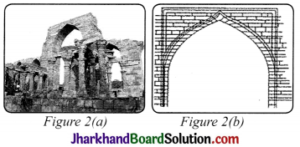JAC Board Class 7 Social Science Notes History Chapter 2 New Kings and Kingdoms
→ Many new dynasties came into existence in the subcontinent between seventh and twelfth centuries.
→ The Emergence of New Dynasties:
- There were big landlords or warrior chiefs in different regions of the subcontinent in seventh century.
- They were working under the existing kings as samantas or subordinates. As moderately they gained power and wealth and eventually they declared themselves to be maha-samanta, maha-mandaleshvara.
- Some of them asserted their independence from their overlords. Rashtrakutas were the subordinates of Chalukyas in Karnataka. Dantidurga, a Rashtrakuta chief, overthrew his Chalukya overlord and performed a ritual called hiranyagarbha (means, the golden womb) in eighth century.
- Some other lords were same as Rashtrakutas were Kadamba Mayurasharman and Gurjara-Pratihara Harichandra who successfully established their kingdoms.
![]()
→ Administration in the Kingdoms:
- Titles such as maharaja-adhiraja (great king, overlord of kings), tribhuvana- chakravartin (lord of the three worlds) were adopted by these new kings. They shared their power with their samantas as well as alliance with traders, brahmanas and peasants.
- Peasants, cattle-keepers, artisans, were persuaded or compelled to surrender part of what they produced. They were the main producers of the states.
- These products were used to finance the king’s establishment, as well as for the construction of temples and forts. They were also used to fight wars, which were in turn expected to lead to the acquisition of wealth and access to land as well as trade routes. Sometimes these were claimed as “rent” due to a lord who asserted that he owned the land. Revenue was also collected from traders.
→ Prashastis and Land Grants:
- Learned Brahmanas composed the Prashastis who often helped the kings in the administration. They tell us how rulers wanted to characterize themselves as heroic, courageous and victorious warriors.
- Long Sanskrit poem was composed by Kalhana, who described the history of kings who ruled over Kashmir. But he was different from the writers of Prashastis as he was very critical and analytical about the kings and their policies.
→ Warfare for Wealth
- The city of Kanauj in the Ganga valley was a specific region, which every dynasty tried to control. For centuries, three main dynasties; Rashtrakuta, Gurjara-Pratihara and Pala dynasties fought over it. Because of this long conflict, historians describe it as the “tripartite struggle”.
- Temples were often targeted when the kings attacked other kingdoms which were sometimes extremely rich. Usually, kings built those to show and exhibit their power and resources.
- One such ruler was Sultan Mahmud Ghazni of Afghanistan, who ruled from 997 to 1030 CE. His main aim was to attack wealthy temples, which included the temple of Somnath, Gujarat. He continued to control over parts of Central Asia, Iran and north¬western part of the subcontinent.
- The Arabic work, known as the Kitab-ul Hind, written by a scholar named Al-Biruni on appeal of Sultan remains an important source for historians. He also consulted Sanskrit scholars to prepare this.
- Some other kings were also engaged in war, those were Chahamanas, later known as the Chauhans, who ruled around Delhi and Ajmer.
- They tried to expand their territories but were opposed by Chalukyas and Gahadavalas in the west and east region.
- The popular Chahamana ruler was Prithviraja III (1168-1192), who defeated an Afghan king, Sultan Muhammad Ghori in 1191, but lost to him the very next year in 1192.
→ A Closer Look-The Cholas
- From Uraiyur to Thanjavur
- In the Kaveri delta, the subordinates to the Pallava kings of Kanchipuram Muttaraiyar rose to power.
- Vijayalaya, who belonged to the family of the Cholas from Uraiyur, captured the delta in the middle of the ninth century. He also built the Thanjavur town and a temple for goddess Nishumbhasudini there.
- The most powerful Chola ruler was Rajaraja I. He expanded his territory over most of. these areas and reorganised the administration of the empire. Rajendra I was Rajaraja’s son and he continued his legacies and policies. He was also very famous like his father.
- Splendid Temples and Bronze Sculpture
- Rajaraja and Rajendra built big temples in Thanjavur and Gangaikonda-cholapuram.
- Temples were the core place of economic, social and cultural life apart from the place of worship.
- Chola bronze images were very extraordinary and considered amongst the finest in the world. These were associated with the temples.
![]()
→ Agriculture and Irrigation
- Agriculture developed a lot and contributed to the achievements of the Cholas.
- They made several water channels which provided the necessary moisture for agriculture especially cultivation of rice.
- Different methods were used for irrigation such as huge tanks were constructed to collect rainwater, digging of wells. Irrigation works require planning – organising labour and resources, maintaining these works and deciding on how water is to be shared.
→ The Administratioir of the Empires
- Ur means settlements of peasants, which became prosperous with the spread of irrigation agriculture. Villagers formed larger units in groups called nadu. The village council and the nadu had many administrative services including giving out justice and collecting taxes.
- Some rich landowners got titles from Chola kings like muvendavelan (a velan or peasant serving three kings), araiyar (chief), etc., as markers of respect, and assigned them with important offices of the state at the centre.
- Brahmanas also received land grants or brahmadeya. Hence, a large number of Brahmana settlements rose in the Kaveri valley. Each land was looked after by an assembly or sabha of major Brahmana landholders. These assemblies worked thoroughly and efficiently.
- Nagarams which means associations of traders also occasionally performed administrative functions in towns.
- Inscriptions show that the sabha had separate committees to look after irrigation works, gardens, temples, etc.
